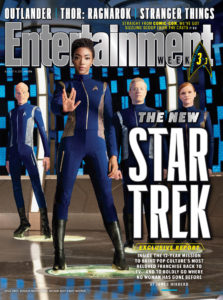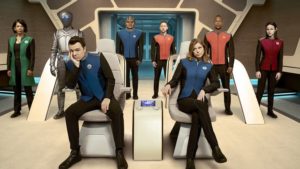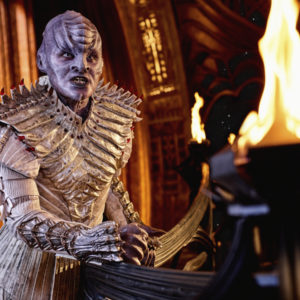Space Operas Leave Me Star-Crossed
Posted on November 15th, 2017 in Entertainment, Television with 0 Comments
The odd thing about the fall TV season’s two new space-travel series is that Fox’s The Orville more resembles a traditional Star Trek iteration than CBS’ Star Trek: Discovery.
Yes, it’s a knockoff – sort of a “Star Trek Lite” – but I haven’t heard anyone complaining or threatening a lawsuit.
Members of the Orville crew exhibit an optimism and bonhomie reminiscent of Star Trek: The Next Generation and Star Trek: Voyager. The sets and colors, even the special effects, are similar. The ship’s doctor is played by Penny Johnson Jerald (Castle and 24), who had a recurring guest role on Star Trek: Deep Space Nine as space station commander Benjamin Sisko’s romantic interest.
Sure, the series reflects satirical sensibility of its creator and star, Seth McFarlane, but not in a heavy-handed or mean-spirited way. It’s more like a seasoning: the first officer being the captain’s ex-wife; the horny, gelatinous crew member in engineering; the fact that shuttles appear to dock in the rear of the ship like anal probes.
Yet, despite the irreverence, each story has a moral – sometimes rather topical. An episode titled “Majority Rule,” for example, portrays the pitfalls of a society that puts literally everything, from facts and science to criminal guilt or innocence, to a public vote.
Episodes tend to be self-contained within an overall sequence.
The Orville boasts an appealing cast. As Capt. Ed Mercer, MacFarlane (Family Guy, American Dad!) is the goodhearted everyman, a departure from the captain-on-a-pedestal common to the genre. To play Cmdr. Kelly Grayson, the aforementioned first officer/ex-wife, McFarlane landed my homegirl Adrianne Palicki (Agents of S.H.I.E.L.D. and Friday Night Lights). [Click here for my review of the indie film Baby Baby Baby (2015), starring Palicki.] The bridge’s court jester, helmsman Gordon Malloy, is portrayed by Scott Grimes (American Dad! and ER).
One surprise has been the A-list guest stars McFarlane has been able to recruit: Charlize Theron and Liam Neeson so far.
A Different Discovery
It’s become cliche to say that Discovery is dark, but the adjective fits on multiple levels:
- The premiere launches a war between the Federation and the Klingons.
- What makes the USS Discovery special is a revolutionary but morally dubious propulsion system.
- The characters are motivated in large part by fear and suspicion, and exhibit little camaraderie.
- Sudden, fatal violence claims a shocking number of characters in just the first few episodes.
- Even the lighting is low, conveying a sense of bleakness and reinforcing the Discovery captain’s unique vision troubles. It’s even darker in the Klingon scenes, where – additionally – the dialogue is in Klingon with English subtitles.
- It’s almost a sort of “space noir.” While characters in previous iterations of Star Trek have been bound together by a noble common purpose, most of those on Discovery seem to have their own, oft-hidden agendas.
- The Discovery-era Starfleet gives lip service to that noble purpose but places it firmly on the back burner, citing the immediate need to win the war. The viewer can sense a malevolent tension in the background that sometimes crosses over to the creepy.
At this point, I think it’s safe to reveal that much of Star Trek: Discovery’s advance promotion was misdirection. The headline was that the story would be told through the perspective of a first officer rather than a captain; well, that lasted for about three quarters of the two-episode premiere. Michelle Yoeh’s character, Capt. Philippa Georgiou, dies at its end. And the premiere is set on Georgiou’s starship, the USS Shenzhou; Discovery doesn’t show up until Episode 3.
Michelle Yoeh’s character, Capt. Philippa Georgiou, dies at its end. And the premiere is set on Georgiou’s starship, the USS Shenzhou; Discovery doesn’t show up until Episode 3.
Played by Sonequa Martin-Green (The Walking Dead), lead character Michael Burnham is a human who was raised on Vulcan after Klingons killed the rest of her family. Her foster parents were Vulcan/Federation Ambassador Serek (James Frain, who played the stylish enforcer Ferdinand on Orphan Black) and his human wife, Amanda, portrayed in Episode 6 by Mia Kirshner (Defiance, The L Word and Exotica). Those of you who have been paying attention realize that means her foster brother is an as-yet-unseen Spock.
In the Trek canon, half-human Spock’s personality is primarily Vulcan, making it all the more impactful when he gets in touch with his human side. Though equally brilliant and a graduate of the Vulcan Science Acadamy, human Burham is less of a walking computer. She has the personality of an introverted human and seems to be constantly weighing the logical against the moral. But her Vulcan training emerges in moments of crisis, and not always for the better.
Discovery Capt. Gabriel Lorca (Jason Isaacs) is haunted by his past and obsessed with defeating the Klingons. He also may be batshit crazy, a possibility that adds tension for viewers every time he makes a critical decision.
As First Officer Saru, Doug Jones (Falling Skies, Hellboy) is once again hidden in costume as a non-human. His species, Kelpian, is prey on its home world and has developed a heightened sense for danger. Saru was subordinate to Burnham on the Shenzhou and now is her superior – though she often acts under Lorca’s direct orders. Thus, their relationship is complicated. On both the Shenzhou and Discovery, Saru’s ambitions have been frustrated by the captains favoring Burnham.
Other notable crew members are: Cadet Sylvia Tilly (Mary Wiseman), Burnham’s cabinmate, who primarily functions to draw out Burnham’s personality and provide comic relief; Lt. Ash Tyler (Shazad Latif), a POW whom Lorca frees and makes chief of security on Discovery, and who becomes a love interest for Burnham; Lt. Paul Stamets (Anthony Rapp), who oversees the problematic propulsion system; and ship’s doctor Hugh Culber (Wilson Cruz), Stamets’ love interest.
Most of the Klingons have been killed in rapid succession, the exception being L’Rell, played by Mary Chieffo, who has proven adept at survival and torture.
The Klingons, by the way, appear to have undergone another species-wide evolution – appearing meaner and more reptilian than the ’60s-era Klingons in the original Star Trek and the large-headed specimens from TNG, DS9 and Voyager. I realize this has more to do with advances in makeup and special effects, but it clashes with a timeline that puts Discovery before the other Star Trek TV shows and movies.
Other than Kirshner’s scene as Amanda, the only notable guest star in Discovery’s first half-season has been Rainn Wilson (The Office) as Harcourt Fenton “Harry” Mudd, a character from the original Star Trek, who is the antagonist in two episodes. On Discovery, episodes may have their own plot, but each is tied into, and advances, the season’s arc and Trek mythology.
Stream Is No Dream
I would be remiss if I didn’t address the elephant in the room: distribution. Since a first-episode tease on CBS, Star Trek: Discovery has been available only on the network’s subscription streaming service, CBS All Access.
While I enjoy the series, I find viewing it through the All Access interface less than optimal. Watching a show that is fast-paced and dimly lit, it’s nice to have the ability to rewind a few seconds if you think you’ve missed something. All Access fails to offer that feature; trying to skip around manually is clunky and frustrating – and can dump you into one of the lengthy, repetitive commercial breaks. (You can avoid the latter with a premium subscription.)
“Trek often portrays a rosy picture of humanity’s future. But CBS’s decision to hide Discovery inside its silo app as a prestige lure for people to pony up is a potentially worrying picture of TV’s future, one in which we’re asked to pay for a slew of single-entity streaming services.”
~ Popular Mechanics, Sept. 2017
An All Access subscription is $5.99 a month, or $9.99 commercial-free. I tried the former via an introductory offer. It turns out that Discovery is the only thing I watch. Who has time for its syndicated and archived programming? I can barely keep up with all the new stuff on television. As the magazine Popular Mechanics put it in a September 2017 article: “Trek often portrays a rosy picture of humanity’s future. But CBS’s decision to hide Discovery inside its silo app as a prestige lure for people to pony up is a potentially worrying picture of TV’s future, one in which we’re asked to pay for a slew of single-entity streaming services.”
And with the show going on midseason hiatus until January, folks who subscribe solely for Discovery face paying for nothing in December.
While the show has generated some buzz online, I don’t sense that it has dominated the water cooler – i.e., become something you have to watch ASAP in order to be part of the conversation. To me, it’s more like a Netflix or Amazon Prime series that one can binge-watch when it’s convenient. Thus, since episodes are archived, I think the most economical thing to do would be to subscribe for a month at the end of the season and watch all of the episodes.
###
Stu Robinson does writing, editing, media relations and social media through his business, Phoenix-based Lightbulb Communications.
Tags: Adrienne Palicki, Anthony Rapp, CBS, CBS All Access, Deep Space Nine, Discovery, Doug Jones, James Frain, Jason Isaacs, Klingons, Mary Chieffo, Mary Wiseman, Next Generation, Penny Johnson Jerald, Scott Grimes, Seth McFarlane, Shazad Latif, Sonequa Martin-Green, Star Trek, The Orville, Voyager, Wilson Cruz







COMMENTS
There are no comments yet.